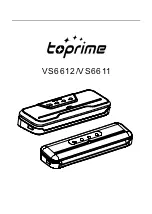
61
GUIDELINES FOR PREPARING FOOD
• Always check up on your food for perfect condition, before sealing and again
before consumption.
• Vegetables need to be blanched to stop the enzyme reaction causing loss in
quality. Finally, dab dry the vegetables via a kitchen towel before vacuum
packaging.
• Some vegetables (broccoli, sprouts, cabbage, cauliflower, kale, turnips) natural-
ly emit gases during storage. Therefore, even after blanching, they must be sto-
red in the refrigerator or freezer only and are not suited for vacuum packaging.
DURING VACUUM SEALING
• Do not overfill the bag. When sealing flat objects, always leave at least 5 cm
(2 inches) of free space on top of the bag material to enable evacuation and
sealing. With large objects, it is better to leave at least 8 cm (3 inches) of free
space above the objects.
• For vacuum sealing large objects, stretch the bag gently flat, while placing it into
the vacuum chamber. Additionally, always ensure that the sealing area of the
foil is completely dry and clean. Wrinkles, liquids and particles on the foil will
prevent airtight sealing.
• When vacuum sealing sharp-edged objects (e.g. bones, spaghetti), protect the
bag from punctures. For this you may wrap the objects in paper towel. Alterna-
tively use a container.
• Pre-freeze delicate food that will be stored in the freezer after vacuum sealing.
This way the food will not be mashed during evacuation and liquids (e.g. juices)
will not be sucked in so easily.
• If the foil material is melted at the rim of the seal, the heating bar may have been
too hot during sealing. To avoid overheating, after each usage allow the heating
bar to cool down for at least 60 seconds with the lid open.
• If in doubt, whether your bag is really airtight, simply make a second seal.
• To ensure best results, only use foils, bags, and containers recommended by the
manufacturer.
















































